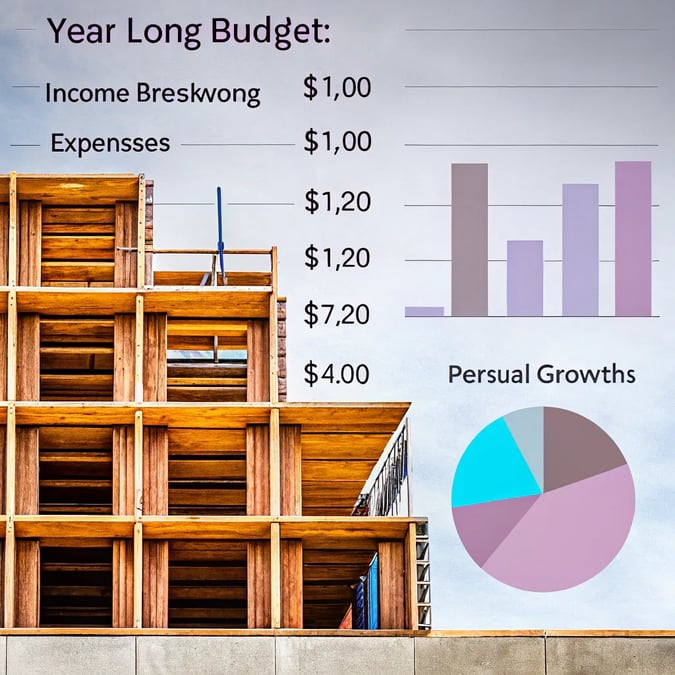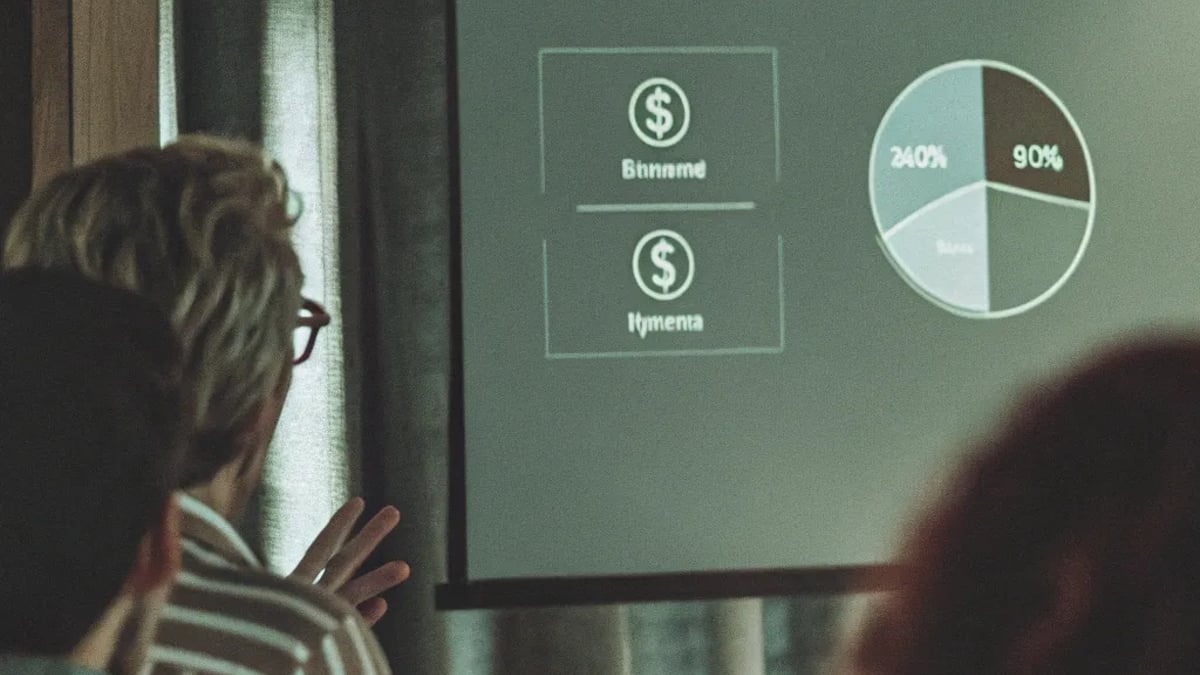
When I decided to track every single dollar I spent for an entire year, I had no idea how dramatically it would change my relationship with money. It started as a simple challenge—could I actually account for all my spending?—but evolved into a financial awakening that revealed patterns I'd been blind to for years. The journey wasn't always smooth, but the insights gained were worth every meticulous entry.
Why I Decided to Budget Every Dollar
Like many people, I used to have a vague idea of where my money went each month. Bills got paid, some savings happened occasionally, and I'd wonder why my account balance never seemed to grow despite what I considered a decent income.
After a particularly frustrating December where holiday spending left me with an uncomfortably low bank balance, I decided something needed to change. I'd heard about zero-based budgeting—the concept of assigning every dollar a specific job—from a colleague who swore it transformed her finances.
"The problem isn't that we don't make enough," she told me over coffee last January. "It's that we don't know where it all goes."

That statement hit home harder than I expected. I'd been making excuses rather than facing the reality of my spending habits. So with a mix of determination and skepticism, I committed to tracking every dollar for the next 12 months.
What Zero-Based Budgeting Actually Means
Zero-based budgeting isn't about spending zero dollars—it's about having zero dollars left unassigned in your budget. The principle is simple: your income minus your expenses should equal zero because every dollar has a designated purpose.
This approach differs from traditional budgeting in a crucial way. Instead of setting category limits and then seeing what's left over, you start with your income and deliberately assign each dollar to a specific category until you reach zero. These categories include:
- Essential expenses (housing, utilities, groceries)
- Debt payments
- Savings goals
- Discretionary spending
- Giving/charity
The beauty of this system is its intentionality. Nothing slips through the cracks because every dollar has a job to do.
Tools That Made It Possible
While some budget-trackers prefer spreadsheets, I knew myself well enough to recognize I needed something more user-friendly and accessible on-the-go. After researching several options, I settled on the EveryDollar app from Ramsey Solutions.
What attracted me to EveryDollar was its straightforward interface and the philosophy behind it. Created by financial expert Dave Ramsey, the app is specifically designed for zero-based budgeting. The free version requires manual entry of transactions, which initially seemed tedious but ultimately proved valuable—physically entering each purchase made me more aware of my spending.
Other tools I considered included:
- YNAB (You Need A Budget): Another zero-based budgeting tool with a strong community
- Mint: Good for tracking but less focused on planning ahead
- Personal Capital: Better for investment tracking than day-to-day budgeting
For those who prefer a non-digital approach, the cash envelope system works well alongside zero-based budgeting. This involves placing cash in labeled envelopes for different spending categories and stopping when an envelope is empty.
The First Month: Shocking Revelations
The initial weeks of my budgeting experiment were eye-opening, to say the least. I created my first budget with confident estimates of what I thought I spent in each category. Reality quickly humbled me.
By mid-January, I realized my grocery estimates were off by nearly 40%. I'd budgeted $400 but was on track to spend over $550. My "occasional coffee" habit turned out to be a $15-20 weekly expense rather than the monthly treat I'd imagined it to be.
Even more surprising was discovering how many subscriptions I was paying for but barely using. A streaming service I hadn't watched in months, a magazine subscription I'd forgotten about, and a premium app I'd signed up for during a free trial were silently draining my account.
That first month ended with me overspending in seven categories and scrambling to adjust others to compensate. It wasn't pretty, but it was educational. I realized I'd been living in a state of financial denial.
The Emotional Side of Tracking Every Dollar
What I didn't anticipate was the emotional journey. Tracking expenses triggered feelings ranging from shame (did I really need that impulse purchase?) to pride (I stayed under budget in restaurants this week!) to occasional resentment (entering every stick of gum became tedious).
Some days, I avoided checking the app because I didn't want to face my spending decisions. Other days, I felt empowered by the growing awareness of my financial habits. The process forced me to confront the gap between my stated values and where my money actually went.
Dr. Brad Klontz, a financial psychologist, explains this phenomenon: "Money behaviors are often driven by unconscious beliefs formed in childhood. Tracking spending brings these beliefs into conscious awareness where they can be examined and changed."
Adjustments and Adaptations Throughout the Year
As the months progressed, my budgeting approach evolved. Here's how the journey unfolded:
Months 1-3: The Learning Curve The initial period was all about discovery. I constantly adjusted category amounts as I learned my true spending patterns. I overspent regularly but became increasingly accurate with my projections.
Months 4-6: Finding Rhythm By this point, I had established more realistic category amounts and developed habits that made tracking easier. I started planning my budget before the month began rather than creating it on the first day.
Months 7-9: Automation and Refinement I implemented some strategic automation, setting up recurring transactions for fixed expenses. This period also saw me refining categories—splitting "Entertainment" into more specific groups after realizing how varied those expenses were.
Months 10-12: Strategic Planning In the final quarter, I began using my budget not just to track spending but to actively plan for future goals. The holidays approached with much less financial stress than the previous year because I'd been setting aside money each month in a "Holiday" category.
What Worked and What Didn't
Through trial and error, I discovered which budgeting strategies were most effective for my lifestyle:
What Worked:
- Weekly budget check-ins: Reviewing my progress every Sunday evening helped me stay on track and make mid-month adjustments.
- The 24-hour rule: For non-essential purchases over $50, I waited 24 hours before buying. About 70% of the time, I decided against the purchase.
- Sinking funds: Setting aside small amounts monthly for irregular expenses (car maintenance, annual subscriptions, etc.) prevented these from becoming budget emergencies.
- Cash for problem categories: Using physical cash for categories where I consistently overspent (dining out, clothing) helped create a tangible spending limit.
What Didn't Work:
- Overly detailed categories: Initially, I created too many specific categories, making tracking cumbersome. I later consolidated related expenses.
- Rigid category limits: Some months naturally had higher expenses in certain categories. Learning to be flexible while maintaining overall limits was crucial.
- Neglecting fun money: My first budget versions were too austere, with nothing allocated for spontaneous enjoyment. This led to budget rebellion and overspending.
- Perfection mindset: Early on, I'd get discouraged when I couldn't perfectly track every penny. Accepting that 95% accuracy was still valuable helped me persist.
How Did My Finances Change After a Year?
The financial impact of my year-long experiment was substantial:
- Savings increased by 27%: By identifying and eliminating wasteful spending, I redirected money to savings goals.
- Debt reduced by $4,800: Becoming aware of interest costs motivated me to accelerate debt payoff.
- Net worth grew by 18%: The combined effect of increased savings and debt reduction substantially improved my financial position.
- Stress decreased immeasurably: Financial anxiety diminished as I gained control and awareness of my money.
Perhaps most significantly, I developed a sustainable system that worked with my life rather than against it. My budget evolved from a restrictive plan I resented to a flexible tool that helped me align spending with priorities.
What Would I Do Differently?
If I were starting this journey again, I'd make several adjustments:
- Start with broader categories: Begin with fewer, more general spending categories and get more specific only where patterns show it's needed.
- Build in buffer money: Allocate a small "miscellaneous" fund from the beginning to catch unexpected expenses.
- Focus on big wins first: I initially obsessed over small purchases while ignoring larger opportunities for savings in housing and transportation costs.
- Involve my partner earlier: Waiting several months before getting my spouse fully on board created unnecessary friction.
- Set clearer goals: Having specific, meaningful financial targets from the start would have provided stronger motivation during difficult periods.
How Can You Budget Every Dollar?
If you're inspired to try zero-based budgeting yourself, here's a simplified process to get started:
- Calculate your monthly income: Include all sources of expected income.
- List essential expenses first: Housing, utilities, groceries, transportation, and minimum debt payments.
- Allocate for financial goals: Savings, debt payoff beyond minimums, and investments.
- Plan for irregular expenses: Create sinking funds for predictable but non-monthly costs.
- Assign remaining dollars to discretionary categories: Entertainment, dining out, shopping, etc.
- Track spending consistently: Whether through an app, spreadsheet, or paper, record transactions regularly.
- Adjust as needed: Your first budget won't be perfect. Refine it each month based on what you learn.
The Military One Source Blog Brigade suggests that military families (and civilians too) should "revisit your budget regularly—at least quarterly—to account for changes in income, expenses, or financial goals." This proved essential in my experience as well.
Which Budgeting Tools Should You Consider?
The Mississippi State University Student Money Management Center recommends evaluating your personal preferences when choosing budgeting tools. Some options to consider:
- EveryDollar: Excellent for zero-based budgeting beginners
- YNAB (You Need A Budget): More robust features with a stronger emphasis on looking ahead
- Spreadsheet templates: Maximum customization for the technically inclined
- Pencil and paper: Sometimes the simplest approach works best for visual learners
Remember that the best system is the one you'll actually use consistently.
Common Questions About Zero-Based Budgeting
Is zero-based budgeting too time-consuming for busy people?
This was my biggest concern when starting. The reality is that it does require an investment of time, especially in the beginning. However, after the initial learning curve, I spent about 15-20 minutes per week maintaining my budget. The time investment paid dividends in reduced financial stress and improved financial outcomes.
For extremely busy individuals, starting with just tracking spending for a month before implementing a full zero-based budget can make the process more manageable. The key is finding a sustainable approach that works with your lifestyle.
The Psychological Benefits I Didn't Expect
Beyond the financial improvements, the psychological benefits of budgeting every dollar surprised me:
- Reduced money arguments: Having clear spending guidelines eliminated many potential conflicts with my partner.
- Increased confidence: Knowing exactly where I stood financially empowered better decision-making in all areas.
- Mindful consumption: I became more intentional about purchases, considering value rather than just price.
- Alignment with values: My spending gradually shifted to better reflect what I truly care about rather than responding to marketing or social pressure.
As researcher Elizabeth Dunn notes in her book "Happy Money," "It's not how much money you have that brings happiness; it's how you spend it." My budgeting journey confirmed this wisdom.
Final Thoughts: Is It Worth It?
After 365 days of tracking every dollar, would I recommend the experience? Absolutely—with caveats.
Zero-based budgeting transformed my financial life, but it's not a magical solution. It requires consistency, honesty, and willingness to confront uncomfortable spending truths. The process works best when viewed as a flexible tool rather than a rigid set of rules.
For those considering this approach, I'd suggest starting with a three-month commitment. This provides enough time to move past the initial learning curve while not feeling overwhelming. You can always extend the experiment if you find value in it.
Remember that budgeting systems should serve your goals, not the other way around. The ultimate measure of success isn't perfect adherence to a budget but progress toward financial wellbeing and peace of mind.
Disclaimer: This article is based on personal experience and is provided for informational purposes only. It is not intended as financial advice. Financial situations vary, and you should consult with a qualified financial professional before making significant financial decisions.
Tags

About Graham Elwood the Author
Graham Elwood is a seasoned finance journalist with a keen eye for uncovering the most inspirational success stories in the financial sector, particularly those involving groundbreaking startups and visionary entrepreneurs.
Recommended Articles
Finding Reliable Cars at Police Impound Sales
Explore how to find reliable vehicles at police impound sales and learn valuable tips for successful bidding and inspection.
8 Bulk Buys That Can Save You Over Time
Discover 8 bulk buys that can save you money over time, from rice to cleaning supplies. Learn to shop smart and save!
Zepbound for Sleep Apnea? Here’s What to Know
Discover how Zepbound, an FDA-approved medication, may aid in treating sleep apnea linked to obesity through weight loss and lifestyle changes.
Why Everyone Is Buying This Christmas Decoration Early This Year
This year, early Christmas decoration shopping is on the rise, driven by consumer behavior and past supply chain disruptions.
Goodbye Plain Concrete: The Driveway Look Everyone Wants
Transform your dull concrete driveway with stylish alternatives! Discover options that enhance curb appeal and boost your home's value.




